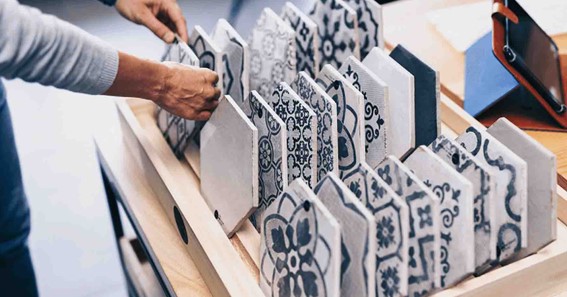Are you curious to know what is a rectified tile? You have come to the right place as I am going to tell you everything about a rectified tile in a very simple explanation. Without further discussion let’s begin to know what is a rectified tile?
If you’re planning to renovate your home or office space, you might be considering using rectified tiles for your flooring or walls. Rectified tiles are becoming increasingly popular in the world of interior design due to their precise edges and sleek, modern look. In this blog, we will explore what rectified tiles are, how they differ from traditional tiles, and the benefits of using them.
What Is A Rectified Tile?
Rectified tiles are ceramic or porcelain tiles that have been precisely cut and ground to achieve a uniform shape and size. Unlike traditional tiles, which have slightly rounded or beveled edges, rectified tiles have straight, sharp edges that allow for a clean and seamless installation. This precision cutting and grinding process gives rectified tiles a sleek and modern look that is particularly popular in contemporary and minimalist interior design.
How Do Rectified Tiles Differ From Traditional Tiles?
The main difference between rectified tiles and traditional tiles lies in their edges. Traditional tiles have slightly rounded or beveled edges, which can make it difficult to achieve a completely flat surface during installation. On the other hand, rectified tiles have straight, sharp edges that allow for a tighter and more precise installation.
Benefits Of Using Rectified Tiles
- Precise Installation: The uniform shape and size of rectified tiles allow for a tighter and more precise installation, resulting in a flat and seamless surface.
- Modern Look: The sharp edges and clean lines of rectified tiles give them a sleek and modern look that is particularly popular in contemporary and minimalist interior design.
- Large Format Options: Because rectified tiles can be cut and ground to precise sizes, they are available in larger formats than traditional tiles, making them ideal for creating large, uninterrupted surfaces.
- Easy to Clean: The flat surface of rectified tiles makes them easy to clean and maintain, as there are no crevices or grooves where dirt and grime can accumulate.
- Durable: Like traditional tiles, rectified tiles are durable and resistant to scratches, stains, and moisture, making them ideal for high-traffic areas such as kitchens and bathrooms.
Conclusion
In conclusion, rectified tiles are ceramic or porcelain tiles that have been precisely cut and ground to achieve a uniform shape and size with straight, sharp edges. They offer a modern and sleek look, precise installation, and easy maintenance, making them a popular choice for contemporary and minimalist interior design. If you’re considering using rectified tiles for your next renovation project, be sure to consult with a professional installer to ensure a successful and long-lasting installation.
On Eagerclub you will get to know more interesting topics like these.
FAQ
Is Rectified Tile Better?
Because rectified tiles may be more prone to edge chipping, a very fine bevel is added to the edge for protection. Non-rectified tile is less expensive, due to the extra manufacturing processes required for rectification. The edges are less sharp, which may be desirable in a more casual, natural-looking installation.
Are Rectified Tiles Harder To Install?
In Summary, rectified tiles may take longer and be slightly more expensive to lay, however, they aesthetic appeal of the smaller grout joints in conjunction with the use of a proper levelling system to ensure a perfect job, will far outweigh any cost.
How Do You Know If Your Tile Is Rectified?
The first non-rectified or pressed tile back has a regular border around the edges. This non-rectified tile has a regular outline around the edges. Compare that to the rectified tile below where the regular border isn’t present on the side where the cutting or grinding took place. This is a tell-tale of rectification.
Do You Need To Grout Rectified Tile?
In truth, rectified tiles allow for a thinner grout line. But, the misconception that they can go groutless might leave your work looking unprofessional. Rectified tiles still very much rely on grout if you want them to withstand the test of time.
I Have Covered All The Following Queries And Topics In The Above Article
What Is A Rectified Edge Tile
What Is A Non Rectified Tile
What Is A Rectified Edge On A Tile
Rectified Tile Pros And Cons
Laying Rectified Tiles
Is Rectified Tile Harder To Install
Are Rectified Tiles Better
12×24 Rectified Porcelain Tile
Rectified Porcelain Tile Meaning
Pressed Vs Rectified Tile
What Is A Rectified Tile
What are the disadvantages of rectified tiles
What is rectified tile?
